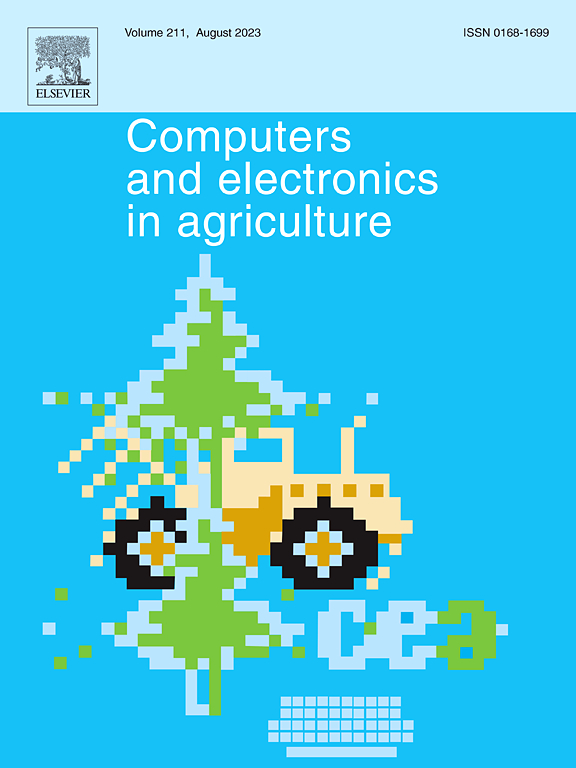开发物联网驱动的德尔塔机器人,利用机器视觉技术刺激空气栽培桑树枝条的生长
IF 8.9
1区 农林科学
Q1 AGRICULTURE, MULTIDISCIPLINARY
引用次数: 0
摘要
机器视觉在自动监测桑枝扦插(Mbc)在气培系统中的生长,确保生产力,质量和可持续性方面起着关键作用。然而,挑战在于不同的芽生长速度,有些需要更长的时间才能打破休眠,导致发育不一致和根形成延迟。本文旨在开发一种集成物联网(IoT)的delta机器人,配备先进的摄像头数据采集和智能处理。目的是通过精确和快速地检测Mbc生长状态和施加生长刺激来增强气培系统。系统框架需要专门设计的微型机器学习模型,以便在有限的功率和资源下在物联网硬件上高效运行,例如tiny - yolo的轻量级版本,包括YOLOv8-world、YOLOv9、YOLOv10和YOLOv11。这些模型是在Mbc成长过程中从三种不同的摄像机视角(侧面视图、高架视图和角度视图)拍摄的3000幅图像上进行训练的。进一步的优化是通过逐步训练逐步细化权值。人工神经网络,例如反向传播神经网络(BPNN)和弹性网络(ELNET),被用来计算机器人手臂的X、Y和Z坐标。此外,查找表方法通过引用与目标坐标对应的预先存储的数据有效地识别Mbc位置。实验结果表明,优化后的Tiny-YOLOv9 (Pr = 98.3%, Re = 98.5%, Fm = 98.4%, mAP50-90 = 87.3%)在桑枝分类和定位方面均优于其他模型。使用BPNN和ELNET模型进行三台摄像机的数据融合,其效果大大优于单台摄像机。此外,与ELNET相比,臂轴(X, Y, Z)的BPNN模型具有更高的精度。BPNN在所有三个轴(X, Y和Z)上记录的R2值为0.999,相应的RMSE值分别为0.005 (MAE = 0.004), 0.006 (MAE = 0.005)和0.013 (MAE = 0.010)。这项工作可以帮助农业社区监测植物生长情况,作出及时有效的管理决策。它也有很大的希望,以扩大我们的方法,包括其他作物在未来的气耕系统。本文章由计算机程序翻译,如有差异,请以英文原文为准。
Developing an IoT-driven delta robot to stimulate the growth of mulberry branch cuttings cultivated aeroponically using machine vision technology
Machine vision plays a pivotal role in automatically monitoring the growth of mulberry branch cuttings (Mbc) in aeroponic systems, ensuring productivity, quality, and sustainability. However, the challenge lies in the varying bud growth rates, with some taking longer to break dormancy, leading to inconsistent development and delays in root formation. This paper aims to develop an Internet of Things (IoT)-integrated delta robot, equipped with advanced camera data acquisition and intelligent processing. It is intended to enhance aeroponic systems by precisely and rapidly detecting the Mbc growth state and applying growth stimulation. The system framework requires tiny machine learning models specifically designed to function efficiently on IoT hardware with limited power and resources, such as the lightweight versions of Tiny-YOLO, including YOLOv8-world, YOLOv9, YOLOv10, and YOLOv11. These models were trained on 3,000 images captured from three distinct camera perspectives—side view, elevated view, and angled view—during the growth of Mbc. Further optimization was achieved by progressively refining the weights through stepwise training. Artificial neural networks, for instance Back-Propagation Neural Networks (BPNN) and Elastic Net (ELNET), were deployed to compute the X, Y, and Z coordinates of the robot arm. Alongside, the look-up table approach efficiently identified the Mbc locations by referencing pre-stored data corresponding to the target coordinates. The experimental outcomes indicated that the optimized Tiny-YOLOv9 (Pr = 98.3 %, Re = 98.5 %, Fm = 98.4 %, mAP50–90 = 87.3 %) outperformed other models in both classification and localization of mulberry branches. Data fusion from three cameras with BPNN and ELNET models substantially outshined the use of a single camera. Moreover, the BPNN models for the arm axes (X, Y, Z) exhibited superior accuracy compared to ELNET. The BPNN recorded R2 values of 0.999 for all three axes (X, Y, and Z), with corresponding RMSE values of 0.005 (MAE = 0.004), 0.006 (MAE = 0.005), and 0.013 (MAE = 0.010), respectively. This work can assist the agricultural community in monitoring plant growth, enabling timely and effective management decisions. It also holds great promise for expanding our methodology to include other crops in future aeroponic systems.
求助全文
通过发布文献求助,成功后即可免费获取论文全文。
去求助
来源期刊

Computers and Electronics in Agriculture
工程技术-计算机:跨学科应用
CiteScore
15.30
自引率
14.50%
发文量
800
审稿时长
62 days
期刊介绍:
Computers and Electronics in Agriculture provides international coverage of advancements in computer hardware, software, electronic instrumentation, and control systems applied to agricultural challenges. Encompassing agronomy, horticulture, forestry, aquaculture, and animal farming, the journal publishes original papers, reviews, and applications notes. It explores the use of computers and electronics in plant or animal agricultural production, covering topics like agricultural soils, water, pests, controlled environments, and waste. The scope extends to on-farm post-harvest operations and relevant technologies, including artificial intelligence, sensors, machine vision, robotics, networking, and simulation modeling. Its companion journal, Smart Agricultural Technology, continues the focus on smart applications in production agriculture.
 求助内容:
求助内容: 应助结果提醒方式:
应助结果提醒方式:


